|
Stryker Area Historic Photos
Stryker United Methodist Church
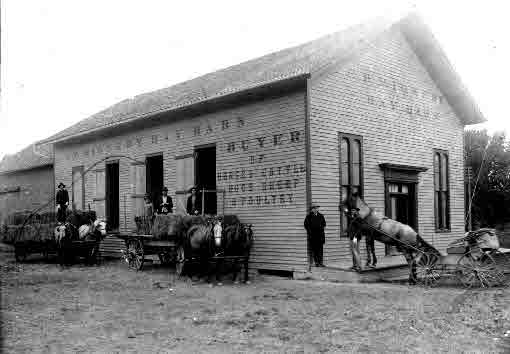 The date the Stryker United Methodist Church was established is unknown, but there is record of a Methodist “protracted meeting” in Stryker in February 1858. In the fall of 1860 the Ohio Methodist Central Conference assigned Rev. H. M. Close to Stryker, so the congregation was probably organized by that time. The date the Stryker United Methodist Church was established is unknown, but there is record of a Methodist “protracted meeting” in Stryker in February 1858. In the fall of 1860 the Ohio Methodist Central Conference assigned Rev. H. M. Close to Stryker, so the congregation was probably organized by that time.
In 1862, Stryker Methodists purchased Lot 7 of Fuller’s Addition for $20. This lot is on the south side of Church Street midway between Center and Defiance Streets.
In 1862 or 1863 the congregation erected the wooden frame house of worship shown above on the lot. The church faced north toward what was then Stryker’s public square and park. According to a local newspaper account the building was not dedicated until 1870 because “considerable debt was left unsatisfied” on the building.
In 1878 significant improvements including a new steeple and bell, and installation of “gothic” stained glass windows were made to the church. The structure served the Stryker Methodist congregation until a new church was completed on the northwest corner of Defiance and Short streets in 1901.
In the spring of 1905 Ernest P. Mignery purchased the former church building, moved it to South Depot Street and converted it into a hay barn shown here. The building and 125 tons of hay were destroyed by fire in July 1909.
This vintage image is from the Williams County Public Library’s Photographic Archives
In 1901, the Stryker Methodist congregation built this large frame church on the northwest corner of Defiance and Short streets to replace a smaller structure erected in the 1860s on Church Street. The house of worship cost about $6,000 and was formally dedicated on January 12, 1902. The structure served Stryker Methodists until 1968 when the congregation completed a new church edifice at the intersection of Maple and Cherry streets.
The old structure at Defiance and Short streets was donated to the Stryker schools. The schools music department used the upper floors of the building for band and choir instruction, and the art department occupied the basement. The building was razed in 1982 following completion of the existing elementary school.
The site is now occupied by the Williams County Public Library’s Stryker branch.
This circa 1907 image is from the Bowling Green State University Center for Archival Collections.
Stryker Drug Store
Anyone remember the Stryker Drug Store? Looks like they’re advertising a cold remedy to cure a child in a day! Wouldn’t we like that today? If you remember anything else about it, let us know. Thanks to Mary Lou Barnum for the photo.
Zion Reformed Church
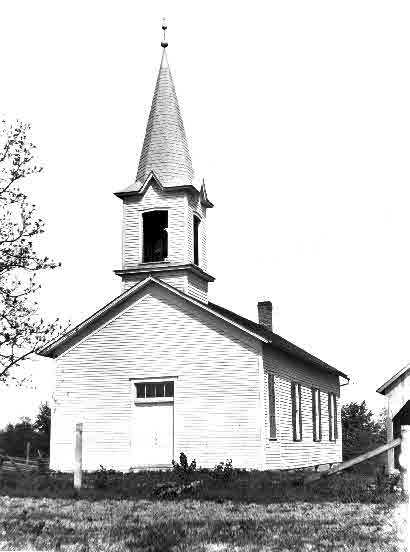 |
St. Jacob’s Reformed Church was organized in 1867. The congregation worshipped in a one-room schoolhouse three miles northeast of Evansport until 1877 when this wooden frame church was erected on the west side of County Road 24, midway between today’s Ohio 34 and U.S. 6.
On January 2, 1878, the congregation adopted the official name “German Reformed Zion Church of the German Reformed Synod of the North West of the United States of America,” but it was commonly known as the Zion Reformed Church. The reason behind the name change is unknown.
Because many in the congregation were Swiss immigrants or the children of Swiss immigrants, services were conducted in Swiss German until 1901, when English language services were introduced.
In 1898, a steeple was added to the building, and Zion's Frauenverein (Ladies Aid) furnished a bell to ring in services.
In 1927—Zion’s 60th anniversary—membership stood at 112; however, like many 20th century rural churches, Zion’s congregation withered away over the next two decades.
In January 1948 the remaining members elected to disband, and 26 transferred to St. John’s Evangelical and Reformed Church in Archbold. The steeple was removed and Zion church was converted into a residence that still occupies the site.
This 1913 photograph was provided by the Stryker Area Heritage Council and was copied from an original owned by Eldred Buehrer of rural Stryker.
St. John’s Catholic Church
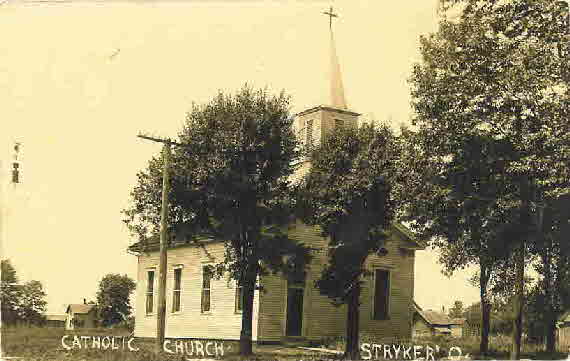 |
Although it is uncertain which congregation was first organized after Stryker was founded in 1853, tradition holds that St. John's Catholic Church erected the first house of worship in town.
St. John's Catholic Church was reportedly organized in November 1861 by Rev. A. J. Hoeffel of Defiance, although services are said to have been held earlier in Patrick Carens' home.
On November 10, 1861, the congregation purchased a lot at the northwest corner of Church and Center streets from John H. Sargent and Epaphras L. Barber, two of Stryker's founders.
The February 11, 1862, issue of the Williams County Leader newspaper reported: "A Catholic church is building in the flourishing town of Stryker." The church was probably completed soon afterward.
The first St. John's Catholic Church was a wooden frame, one-story rectangular building. Its entrance was on the structure's east side, facing the town's park and schoolhouse. Catholics and Protestants united to construct the church building and since there were no other houses of worship in the community, non-Catholics also reportedly attended services there.
For many years St. John's shared a priest with the Catholic missions in Wauseon, Archbold and Bryan. The priest sometimes made the trip to Stryker using a railroad handcar.
In 1956, the wooden frame building that had served St. John's for more than 90 years was moved and a brick structure constructed on the same site that was dedicated June 16, 1957. The old church building was converted into a storage building and was razed sometime around the 1980s.
The last service was held at St. John's Catholic Church on June 27, 2004. The property was purchased by the Stryker Local Schools and razed soon afterward.
Rethmel barn raising
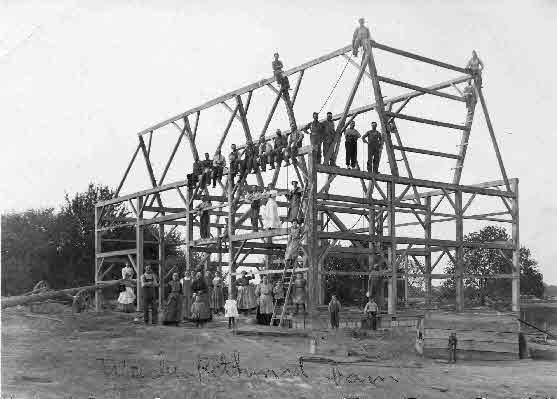 |
Large wooden barns have been a northwest Ohio farm staple since the 1800s, sheltering livestock, providing enclosed work areas and offering storage for hay, straw, grain and farm equipment.
A "barn raising" was often a community event in which neighbors, friends and family members of all ages gathered to construct a barn. While men worked on the barn, youngsters carried water for thirsty workers and fetched needed items, and women prepared bountiful meals for the participants.
This May 1911 photograph shows a group of 41 men, women and children at a barn raising on the Wade Rethmel farm on Rethmel Road south of Evansport. The barn, which still stands, is now owned by Don and Anita Rethmel.
As time passed, wooden barns fell into disfavor due to changes in farming and livestock management practices, larger farm equipment and less maintenance intensive building alternatives. The numerous historic barns that once dotted the local landscape continue to disappear as the years pass, severing an historical tie with the area's early agricultural methods.
Oak Grove Methodist Episcopal Church
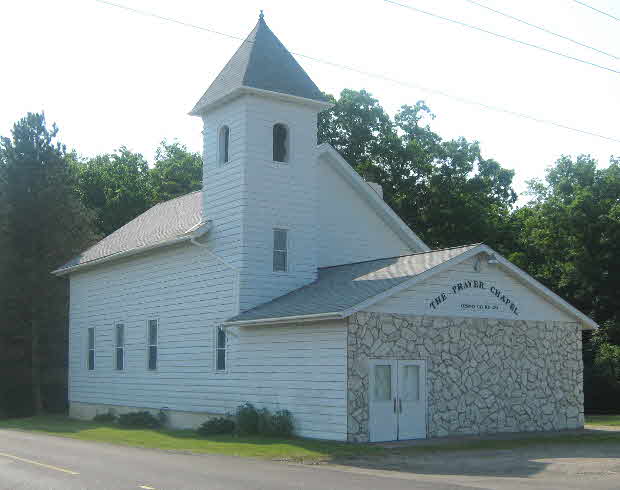 |
Although this photograph is not vintage, the structure certainly is. The Oak Grove Methodist Episcopal Church appears to have been established at the Daniel Colgan family’s log home in 1833. The congregation, known as the “Colgan appointment” met for some time in the Colgan one-room schoolhouse at the corner of County Roads D and 20 and was one of several Methodist churches on the “Stryker circuit” that shared one pastor.
In 1879, Lewis W. and Hannah Prettyman sold one-half acre at the southeast corner of County Roads C and 20 to the Oak Grove Methodist Episcopal Church. Period newspaper accounts indicate the wooden frame house of worship was constructed by Von Behren & Shaffer—owners of the Stryker Boat Oar Company—for $519 and dedicated August 10, 1879.
In February 1923, the Oak Grove church was sold to the Indiana Conference of the Evangelical Church; Evangelical and later Evangelical United Brethren services were conducted there for many years.
In 1949, the Pine Grove Mennonite congregation was organized in the building and worshipped there until the Pine Grove congregation completed a new church in 1951 at the corner of Ohio 34 and County Road 20.50.
In 1951 the Oak Grove church was sold to Oscar and DeNell Robarge of Bryan.
In 1979 the building was sold to the Prayer Chapel, who continues to conduct services in the historic rural church.
If you have a historical photo you would like to share, please send it to the Stryker Area Heritage Council by clicking here.
|

